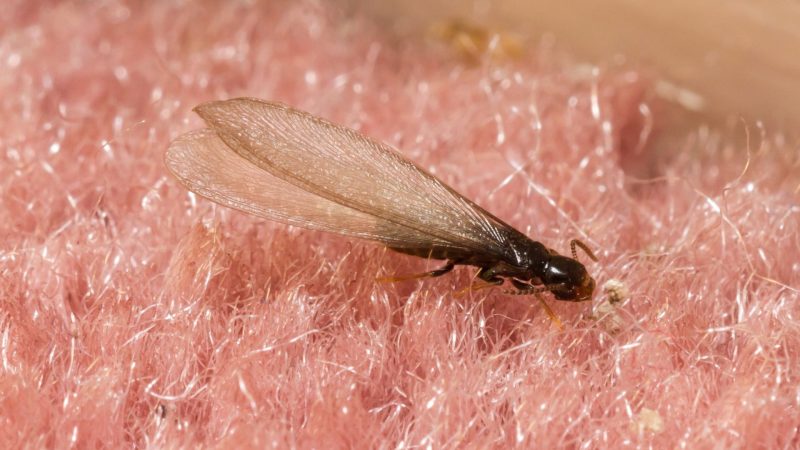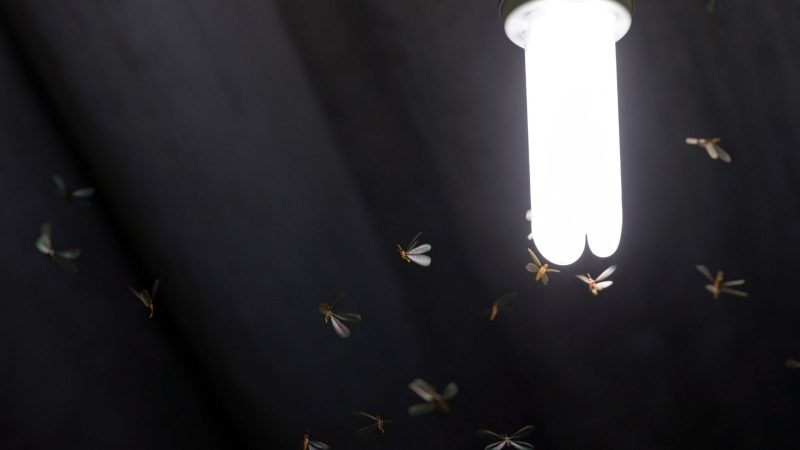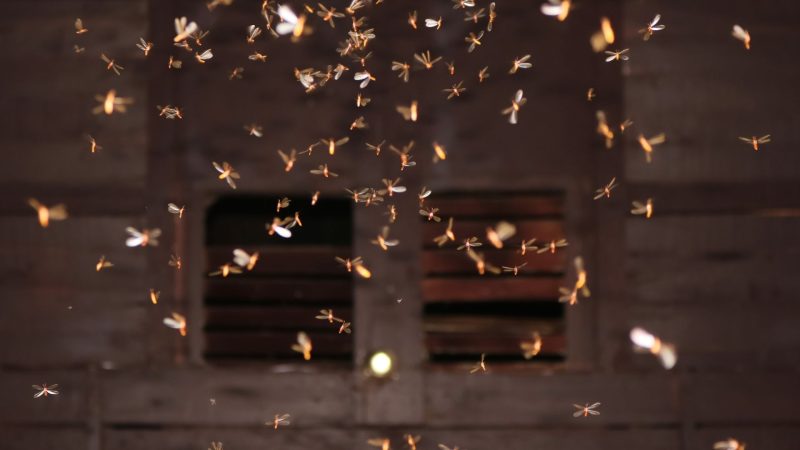Termites are widely known to cause extensive structural damage. Meanwhile, subterranean termites, in particular, are the most notorious for their underground activities, damaging numerous properties.
Do termites fly? Termites do fly, but only some of them. These flying termites are adult reproductive termites commonly known as swarmers. The queen termite produces them and soon leaves their underground nests to mate and start their own colonies.
The termite swarms happen throughout the year. However, they’re most common during warmer weather, specifically in the spring. In this article, you will learn more about them in detail and how to get rid of these pests.
What Do Flying Termites Look Like?

Flying termites are either small or medium-sized (1/4 to 3/8 of an inch), whitish insects with short, straight antennae and two sets of equal-length wings. In addition, they have a straight abdomen with two body segments and a narrow waist.
Their mouthparts are strong at chewing wood, leaves, or seeds. Furthermore, as opposed to the worker termites, which have a lighter color, flying termites tend to have a dark brown or black color.
How Big Are Flying Termites?
The size of flying termites usually depends on their species. But, most typically, flying termites can range from 1/4 of an inch to 3/8 of an inch, depending on their species.
Are All Flying Ants Termites?
Flying ants are not termites. Although flying ants and flying termites vary in so many ways, it can be hard to differentiate them at first look.
Thus, it’s best to look at them closely and compare their sizes. Termites are twice as long as flying ants, and they have clearer color than flying ants.
What Type of Termites Fly?
Flying termites, also known as swarmers, are adult reproductive termites. They’re developed within a colony and leave their nests to mate and make their own colonies.
What Attracts Flying Termites?

Termites are attracted to light sources, such as street lamps or the lights around your home. Although some termite species often swarm late afternoon, others are nocturnal and flock around the lights at night.
You can particularly find them flying around motion lights, porch lamps, and lights reflected within your home.
Do Flying Termites Only Come Out at Night?
Some termite species, particularly the subterranean species, often come out during the day, particularly after the rain, because it increases their chance of survival. Meanwhile, the Formosan termites tend to come out only at night because of the high level of humidity.
Where Do Flying Termites Nest?
Flying termites often nest in the soil to build their colony. To be precise, their nest is found between 4 inches to 18 inches underground.
Their nests comprise many rooms called galleries, which are linked to mud-made tunnels. These tunnels aren’t only connected to galleries but also to the food sources of termites.
Do Flying Termites Bite?
Although flying termites can bite people, they’re not famous for doing so. In most cases, they only bite people and other insects when threatened.
Do Flying Termites Eat Wood?

Flying termites don’t eat wood. They only drill a hole in the woods to get within any wooden structure. They do this to make tunnels and chambers within the wood.
What Is the Difference Between Flying Ants and Termites?
Though both species possess four wings, termites’ wings are equal in size, while winged ants have bigger wings in the front than their back. In addition, the antennae of termites are straight compared to the elbowed antennae of ants.
Furthermore, termite wings are twice the size of their bodies, while ants’ wings are proportional to their bodies. Termites have clear colors, while flying ants have a red, black, or brown color, depending on their species.
Do Flying Termites Come Out After Rain?
Flying termites do come out after the rain. This is because they need moist soil to flourish.
The dampened soil serves as their cue to start the mating process, allowing them to live longer and search for a new mate and nesting area. During this time, termites are extra delicate because of their thin exoskeleton, so they pick the most convenient time to fledge.
Are Flying Termites Dangerous?
Flying termites aren’t dangerous. They don’t cause any structural damage or harm people.
This is because the lifespan of flying termites is just about 30 to 40 minutes. During this time, they’ll fly around light sources and find damp soil to rehydrate themselves.
If they don’t find any damp soil, they’ll likely die after a few hours due to dehydration.
What to Do if You See Flying Termites?

If you see flying termites around your property, this means that a termite infestation is flourishing nearby. Thus, it would be ideal to check your home and its surrounding place for an infestation.
Once the infestation is confirmed, you may use natural or chemical ways to get rid of them. You may also call your local pest control professional to handle the situation for you.
How to Keep Flying Termites Out of Your House?
To keep flying termites out of your house, you must execute preventive measures to secure your place. To do this:
- Store your firewood away from your home.
- Ensure to keep mulch away from your house’s foundation, and make sure that four inches of the foundation are noticeable above the soil.
- Maintain your drainage systems, ensuring to steer rainwater away from your home.
- Inspect your home and eliminate leaks and moisture.
How to Get Rid of Flying Termites Naturally?
Termites can destroy your home if left undetected for a long time. It’ll only take them a short time to chew structural beams, leaving extensive damage in the process.
If you’re currently looking for ways to get rid of flying termites, here are the natural remedies we’ve listed just for you:
Orange Oil
Orange oil is mostly composed of d-limonene—an element deadly to termites. This oil comes from peels of oranges that you can buy from your garden stores.
The orange oil causes the termites’ exoskeletons to dissolve, causing them to lose their moisture, and then die. All you need to do is spray the oil straight into termites or in suspected areas.
Spraying the orange oil will deter termites from coming to your place. So, apply this regularly to make your home termite-free.
Nematodes
Nematodes are tiny parasitic worms that like to nibble termites. These worms are available in specialty stores or online.
All you have to do is release them into the affected area, and they’ll do their work, feeding on termites. The nematodes will breed and proceed to seek out termites until they’re gone completely.
Borates
Borates, commonly known as borax powder, can effectively kill termites. Just sprinkle the powder in the affected area or mix it with water and spray it into the site you believe is infested.
Vinegar
Vinegar is an excellent material for your home. Not only it can be used to disinfect your kitchen counter and shower, but it can also effectively kill termites.
Just mix 1/2 cup of vinegar with the juice of two lemons. Then, put it in a spray bottle and spatter it on the suspected areas.
Sunlight
Termites hate sunlight. Thus, if you have furniture or any wood items infested by termites, just take it out and place it under the sun.
How to Exterminate Flying Termites?
To exterminate flying termites, you may use the following termite-killing solutions:
Bug Zappers
Bug zappers, such as Katchy Indoor Trap and Tiabo Electonic Bug Zapper Insect Killer are great options to eliminate flying termites. They don’t have any chemicals and are odor-free.
Take Action Outdoor
To ensure the elimination of termites in your property, make sure to:
- As much as possible, use only cedar mulch and remove any other mulch outside your home.
- Remove tree stumps.
- You may also use other methods like boric acid, cardboard trap, and orange oil spray.
You may either use natural ways as listed above or use bug zappers to kill the destructive pests.
Related: Flying Insects | Identification, Habitat, and Behavior
List of Sources
Subterranean Termites. University of Missouri.
Field Guide to Common Texas Insects – Insect Orders: Termite. Texas A&M AgriLife Extension.
Waldvogel, M., Alder, P. (2009). Wood-Damaging Pests: Termite Swarmers – What Do They Mean for You? NC State University.
- Bed Bug Surge 2025: How to Detect, Prevent, and Safely Eliminate Infestations in Top U.S. Cities - June 18, 2025
- Asian Needle Ants Invade US Homes: 2025 Guide to Identification, Risks, and Effective Control - June 11, 2025
- New World Screwworm Alert: How US Livestock Owners Can Prevent Outbreaks and Protect Herds [Summer 2025 Update] - June 8, 2025
